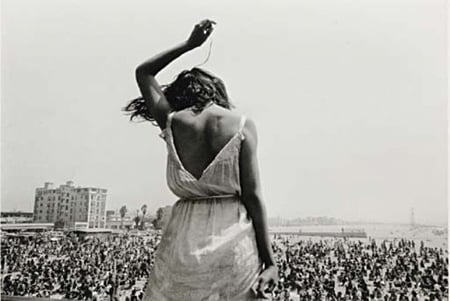
“The goal for the photographer is to be visually articulate. If the subject is in a suffering circumstance, it is all the more preferable to apply craft to the utmost. Call it art or not, we photographers should always try to pass on our observations with the utmost clarity.” — Dennis Stock as quoted in The New York Times Lens Blog
Dennis Stock’s (American 1928–2010) photos present the American experience, be it of a rebel, an ingénue, a groupie, or a pacifist, and the photographer had a knack for not getting in the way of his subject.
His story began in 1947, when he left home to serve in the Navy. Upon his return to civilian life, he worked for LIFE magazine’s Gjon Mili. After assisting Mili for three years, he pursued his own photography career, becoming an associate member of Magnum in 1951 and a full partner-member of the organization in 1954. The photographer had a prolific career; he published a book or mounted an exhibition of his work on a yearly basis.
Dennis Stock, James Dean in Times Square, 1955
Stock is perhaps best known for the portraits he took of Hollywood stars. These images are immediately recognizable, even if the photographer’s name is not. Stock’s photographs of James Dean project the actor’s moody person. The photographer’s most famous photograph of Dean depicts the actor walking down the street in Times Square with his shoulders hunched against the inclement weather, three months before he died in a car crash. Stock also captured Audrey Hepburn’s precocious innocence in his outtakes from the set of Sabrina; his prints of the actress bolster Hepburn’s status as the quintessential ingénue.
Dennis Stock, Audrey Hepburn While Filming ‘Sabrina’, 1954
Gallery goers may come to Milk Studios for the iconic images of Dean and Hepburn, but I am sure that they will leave with a new appreciation for Stock’s reflection of the counter cultures of the 1960s and the 1970s. In the arresting image Venice Beach Rock Festival, California (1968), a woman in rhythm of the music hovers in ecstasy over a crowed beach.
Dennis Stock, Venice Beach Rock Festival, California, 1968
Also in the exhibition is Stock’s whimsical portrait of a pacifist in military-type regalia, promoting peace. Stock, the former Navy man, took this photograph in the height of the Vietnam War, and while the subject is seemingly straight-laced, the subtext of the image is very clever. The headline “Waste more land” on the newspaper alludes to the name of the US commander in chief in Vietnam at the time, General Westmoreland.
Dennis Stock, Pacifist demonstrating at Santa Monica, California, 1968
Some of the digital prints at Milk Studios are much larger than the photographer’s original gelatin silver prints, which elevates his works in the space. In addition, the gallery presents a slideshow of Stock’s photographs, which further exposes the viewer to the photographer’s oeuvre. One hopes that shows like Magnum’s Milk Gallery exhibit will help to give Stock’s lesser known works more exposure.